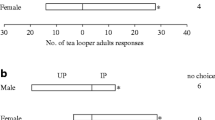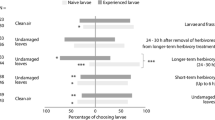Abstract
Using light-emitting diode spotlights, we examined the responses of Cotesia vestalis, a parasitoid of diamondback moth (DBM), Plutella xylostella larvae, with different hunger level to different chromatic cues. Naïve satiated female wasps showed no significant preference for either green, yellow, orange, or red spotlighted areas over a control area with background fluorescent light. When starved for 2 h, female wasps preferred yellow and green light over the control area, but not orange or red light. We also tested the effects of DBM-larvae-induced cabbage-plant volatiles, which attract female wasps, on wasp responses to green versus yellow light. In control experiments with no plant volatiles, starved wasps showed no color preference. However, when synthetic volatiles were present, the wasps preferred green over yellow light. We concluded that both hunger level and herbivore-induced plant volatiles were important factors affecting the response of parasitic wasps to light of different color.



Similar content being viewed by others
References
Arimura G, Matsui K, Takabayashi J (2009) Chemical and molecular ecology of herbivore-induced plant volatiles: proximate factors and their ultimate functions. Plant Cell Physiol 50:911–923
Battaglia D, Poppy G, Powell W, Romano A, Tranfaglia A, Pennacchio F (2000) Physical and chemical cues influencing the oviposition behaviour of Aphidius ervi. Entomol Exp Appl 94:219–227
De Moraes CM, Lewis WJ, Pare PW, Alborn HT, Tumlinson JH (1998) Herbivore-infested plants selectively attract parasitoids. Nature 393:570–573
Desouhant E, Driessen G, Amat I, Bernstein C (2005) Host and food searching in a parasitic wasp Venturia canescens: a trade-off between current and future reproduction? Anim Behav 70:145–152
Desouhant E, Navel S, Foubert E, Fischbein D, Thery M, Bernstein C (2010) What matters in the associative learning of visual cues in foraging parasitoid wasps: colour or brightness? Anim Cogn 13:535–543
Fischer S, Samietz J, Wäckers FL, Dorn S (2003) Perception of achromatic cues during host location of a pupal parasitoid. Entomol Exp Appl 106:63–66
Fischer S, Samietz J, Wäckers FL, Dorn S (2004) Perception of chromatic cues during host location by the pupal parasitoid Pimpla turionellae (L.) (Hymenoptera: Ichneumonidae). Environ Entomol 33:81–87
Ichiki RT, Kainoh Y, Yamawaki Y, Nakamura S (2011) The parasitoid fly Exorista japonica uses visual and olfactory cues to locate herbivore-infested plants. Entomol Exp Appl 138:175–183
Jervis MA (1998) Functional and evolutionary aspects of mouthpart structure in parasitoid wasps. Biol J Linn Soc 63:461–493
Jervis MA, Kidd NAC (1986) Host-feeding strategies in Hymenopteran parasitoids. Biol Rev 61:395–434
Kugimiya S, Uefune M, Shimoda T, Takabayashi J (2010a) Orientation response of the parasitic wasp, Cotesia vestalis (Haliday) (Hymenoptera: Braconidae), to visual and olfactory cues of field mustard flowers, Brassica rapa L. (Brassicaceae), as a potential nectar source. Appl Entomol Zool 45:369–375
Kugimiya S, Shimoda T, Tabata J, Takabayashi J (2010b) Present or past herbivory: a screening of volatiles released from Brassica rapa under caterpillar attacks as attractants for the solitary parasitoid, Cotesia vestalis. J Chem Ecol 36:620–628
Langley SA, Tilmon KJ, Cardinale BJ, Ives AR (2006) Learning by the parasitoid wasp, Aphidius ervi (Hymenoptera: Braconidae), alters individual fixed preferences for pea aphid color morphs. Oecologia 150:172–179
Lobdell CE, Yong TH, Hoffmann MP (2005) Host color preferences and short-range searching behavior of the egg parasitoid Trichogramma ostriniae. Entomol Exp Appl 116:127–134
Lucchetta P, Bernstein C, Thery M, Lazzari C, Desouhant E (2008) Foraging and associative learning of visual signals in a parasitic wasp. Anim Cogn 11:525–533
Maeda T, Takabayashi J, Yano S, Takafuji A (2000) Effects of light on the tritrophic interaction between kidney bean plants, two-spotted spider mites and predatory mites, Amblyseius womersleyi (Acari : Phytoseiidae). Exp Appl Acarol 24:415–425
Mitsunaga T, Shimoda T, Yano E (2004) Influence of food supply on longevity and parasitization ability of a larval endoparasitoid, Cotesia plutellae (Hymenoptera: Braconidae). Appl Entomol Zool 39:691–697
Mitsunaga T, Shimoda T, Mukawa S, Kobori Y, Gotoh C, Suzuki Y, Yano E (2012) Color and height influence the effectiveness of an artificial feeding site for a larval endoparasitoid, Cotesia Vestalis (Haliday) (Hymenoptera: Braconidae). Jpn Agric Res Q 46:161–166
Osche G (1983) Optical (visual) signals in the coevolution of plants and animals. Ber Dtsch Bot Ges 96:1–27
Rousse P, Chiroleu F, Domerg C, Quilici S (2007) Naive Fopius arisanus females respond mainly to achromatic cues. Biol Control 43:41–48
Shiojiri K, Takabayashi J, Yano S, Takafuji A (2000) Flight response of parasitoid toward plant-herbivore complexes: a comparative study of two parasitoid-herbivore systems on cabbage plants. Appl Entomol Zool 35:87–92
Shiojiri K, Ozawa R, Kugimiya S, Uefune M, van Wijk M, Sabelis MW, Takabayashi J (2010) Herbivore-specific, density-dependent induction of plant volatiles: honest or “cry wolf” signals? PLoS ONE 5:e12161
Sokal RR, Rohlf FJ (1995) Two-way anova without replication in biometry: the principles and practice of statistics in biological research, 3rd edn. W. H. Freeman and Company, New York, USA, pp 342–368
Uefune M, Kugimiya S, Sano K, Takabayashi J (2012a) Herbivore-induced plant volatiles enhance the ability of parasitic wasps to find hosts on a plant. J Appl Entomol 136:133–138
Uefune M, Choh Y, Abe J, Shiojiri K, Sano K, Takabayashi J (2012b) Application of synthetic herbivore-induced plant volatiles causes increased parasitism of herbivores in the field. J Appl Entomol 136:561–567
Wäckers FL (1994) The effect of food deprivation on the innate visual and olfactory preferences in the parasitoid Cotesia rubecula. J Insect Physiol 40:641–649
Wäckers FL (2004) Assessing the suitability of flowering herbs as parasitoid food sources: flower attractiveness and nectar accessibility. Biol Control 29:307–314
Weevers T (1952) Flower colours and their frequency. Acta Bot Neerl 1:81–92
Yoneya K, Kugimiya S, Takabayashi J (2009) Can herbivore-induced volatiles inform predatory insects about the most suitable stage of its prey? Physiol Entomol 34:379–386
Acknowledgments
We thank Koji Yamamura (NIAES) for his comments on statistical analyses. This research was financially supported in part by the Global Center of Excellence Program “Formation of a Strategic 338 Base for Biodiversity and Evolutionary Research: from Genome to Ecosystem” of the Ministry of Education, Culture, Sports, Science and Technology (MEXT), Japan; a Core-to-Core project from the Japan Science and Technology Agency; a Grant-in-Aid for Young Scientists (B) from the Japan Society for the Promotion of Science (No. 24780049); and a Grant-in-Aid for Scientific Research (S, B) from MEXT, Japan (Nos 19101009, 22380038).
Author information
Authors and Affiliations
Corresponding author
Additional information
Handling Editor: Stefano Colazza
Rights and permissions
About this article
Cite this article
Uefune, M., Kugimiya, S., Shimoda, T. et al. Starvation and herbivore-induced plant volatiles affect the color preferences of parasitic wasps. BioControl 58, 187–193 (2013). https://doi.org/10.1007/s10526-012-9483-x
Received:
Accepted:
Published:
Issue Date:
DOI: https://doi.org/10.1007/s10526-012-9483-x




